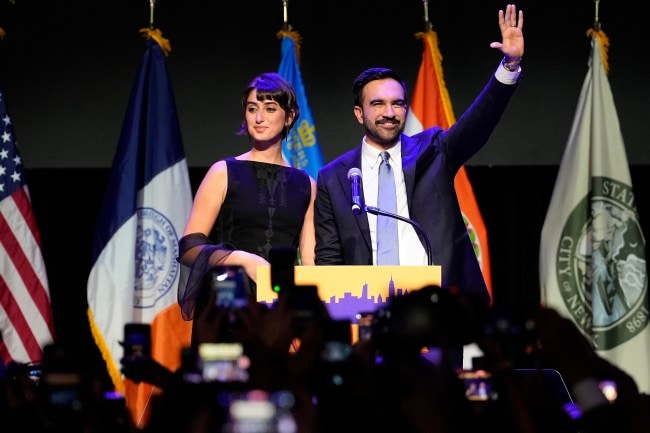Opinion If Zohran Mamdani’s win marks a political shift, wife Rama Duwaji’s fashion marks a cultural one
By choosing a laser-etched tatreez top by a Palestinian designer, the First Lady of New York City turned fashion into a statement of identity, resistance, and solidarity
 The image of Duwaji and Mamdani went viral for a reason. It wasn’t just style that drew attention; it was symbolism (AP/PTI)
The image of Duwaji and Mamdani went viral for a reason. It wasn’t just style that drew attention; it was symbolism (AP/PTI) When Zohran Mamdani celebrated his victory in the New York City mayoral election this week, the cameras naturally turned to him, the young, socialist city council member who has built a reputation as a fierce voice for justice and equality. Yet, in the swirl of celebration, something quieter but equally powerful also caught the world’s eye: Rama Duwaji, his partner, standing beside him in an outfit that was both beautiful and defiant.
Duwaji wore a black, laser-etched tatreez-embroidered top by Palestinian designer Zeid Hijazi paired with a velvet lace skirt by Ulla Johnson. The choice was deliberate. Tatreez, the centuries-old Palestinian embroidery tradition, is not merely decorative. It is an archive of resistance, a coded language of homeland and memory stitched into fabric. In choosing that top, Duwaji wasn’t just dressing for a victory night. She was wearing a story of loss, resilience, and belonging.
At a time when global politics is fractured by wars of identity and geography, when Palestine has become shorthand for erasure and resistance, Duwaji’s outfit reminded the world that expression doesn’t end with words or votes. It continues in fabric, in thread, in silhouette. What we wear can reveal as much about what we believe as what we say.
This was not performance activism or celebrity signalling. It was something more intimate, a woman of Arab heritage standing beside a South Asian immigrant politician, both children of diaspora, both negotiating identity and power in a city that thrives on reinvention. Together, they embody a kind of modern solidarity that goes beyond hashtags, one that is lived, worn, and quietly asserted.
The image of Duwaji and Mamdani went viral for a reason. It wasn’t just style that drew attention; it was symbolism. In a political landscape often saturated with noise, their moment was visually poetic. A black ensemble, laser-etched and hand-embroidered, stood for cultural pride and collective grief. It also stood for something else: The refusal to be invisible.
In the age of algorithmic attention, where meaning is flattened into memes, Duwaji’s choice reminded us that aesthetics can still be subversive. Her outfit didn’t demand applause; it demanded awareness. It asked viewers to look again, to notice what lies beneath the surface: The craftspeople behind the couture, the history behind the stitch, the politics behind the pattern.
The tatreez embroidery pattern on her top is a language of survival that has been passed down through generations of Palestinian women. Each motif tells a story of villages destroyed, of families displaced, of hope preserved through art. In wearing it, Duwaji amplified that story in a space that rarely holds it, an American political victory stage.
Two political acts
It’s also worth noting the context of her partner’s political rise. Mamdani, born to Ugandan-Indian parents, represents a new generation of progressive politicians unafraid to challenge systems of privilege, from housing inequity to climate justice. Duwaji’s choice of attire mirrors that same courage, just expressed differently. Where Mamdani’s campaign demanded structural change, Duwaji’s dress demanded emotional recognition. Both were political acts; one in policy, the other in presence.
What makes this moment compelling is how organically it connects the personal and the political. There was no press release, no stylist statement, no curated activism. Just a young woman dressing with intent, in solidarity with a people whose identity has been continuously contested. In doing so, she gave us one of the most quietly radical fashion moments of the year.
There’s also a lesson here for how we think about “representation”. For too long, the language of diversity in fashion has been limited to inclusion as optics, more faces, more colors, more campaigns. What Duwaji’s ensemble offered was a more grounded idea: Representation as inheritance. To represent isn’t to appear; it’s to carry something forward, a craft, a culture, a cause.
Perhaps that’s why her look struck such a chord. It wasn’t about prestige or price; it was about purpose. In a moment of celebration, she found a way to make visibility meaningful. Her outfit became a bridge between continents, between histories, between struggles. It reminded us that fashion, at its most conscious, doesn’t just express identity, it archives it.
In a world where politics often feels abstract, Duwaji’s choice brought it down to the body, to texture, to fabric, to touch. It reminded us that solidarity can be worn, that resistance can be soft, and that sometimes the loudest statement is the one stitched in silence.
After Mamdani’s win, it wasn’t just the speech or the slogans that lingered; it was also the image. The black ensemble, the tatreez, the quiet confidence of someone who knows exactly what she’s saying without saying a word.
Because in the end, fashion, like politics, is about visibility. And Duwaji made sure that in celebrating victory, the world also saw what still needs to be remembered.
The writer is associate professor at IILM University, Gurugram






